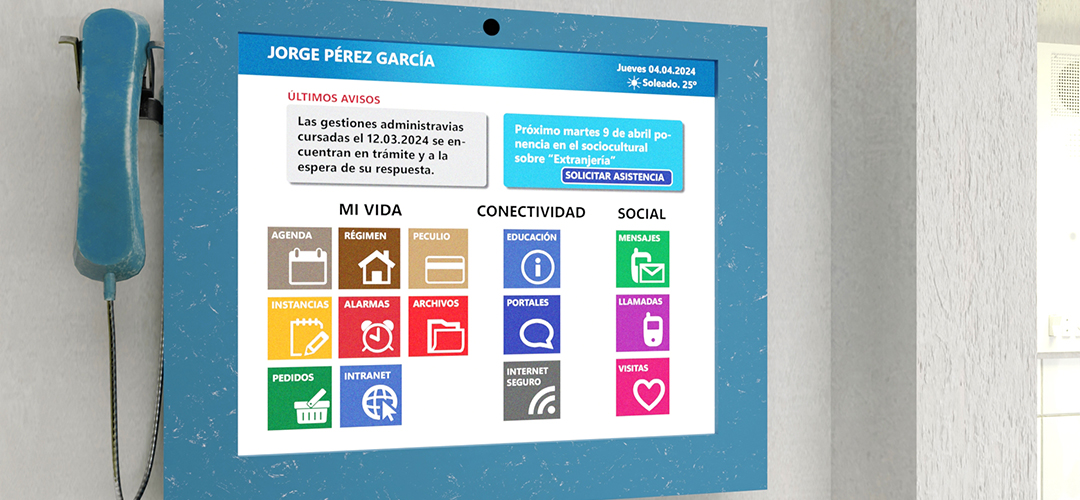
There is increasing awareness of the problems faced by older people when they are unfamiliar with how to use current technologies to carry out routine activities. For this group, paying a service bill or making a bank transfer can become a real ordeal. Issues like these are part of what is known as the digital gap, a concept that generally refers to the inequality in access, use, or impact of Information and Communication Technologies (ICT) among social groups. These groups are usually defined based on economic, geographical, gender, age, or cultural criteria. The digital gap caused by difficulty in access is considered one of the most common, encompassing the inability of people to access a digital resource. The digital gap due to lack of use is also very common, manifesting as a lack of digital skills that prevent a person from using technology.
It is not difficult to imagine why the digital gap affects various groups: people with disabilities, people without the money to buy computers or mobile phones, people living in isolated or poorly covered areas, people who need adaptations to operate devices, etc. However, among these groups, there is one that is often overlooked: that of people who are in prison.
The digital gap not only affects people with long sentences
Several studies prove that people with a long history of incarceration have greater difficulties adapting to new technologies. However, in times when technology is advancing faster than ever and digital skills are required to carry out routine activities or find a job, the digital gap also has a significant impact on those with short sentences.
Adopting digital technologies in prison is a challenge
For budgetary and security reasons, the use of mobile phones is restricted in Spanish prisons, and the use of computers is limited, with no internet access if they exist. Allowing inmates access to the internet or social networks can lead to security breaches or communication with the outside world that compromises prison and citizen safety. To solve these problems, prisons can adopt digital technologies designed specifically for secure and controlled environments.
Inmates believe that digital exclusion is a barrier to their reintegration
From the research on Educommunication, ICTs, and prison. Testimonials from incarcerated individuals about digital exclusion carried out at the Topas Penitentiary Center (Salamanca), the following reflections emerge: “Incarcerated individuals believe that digital exclusion will hinder their reintegration opportunities,” “although there are inmates who have received computer classes while in prison, several show a critical attitude, considering it insufficient both in training time and in the content taught,” “The digital gap in prison has a double path. There is dead time without the possibility of learning, or dead time where they forget what they knew,” “A significant part of those who define themselves as average users have never used a printer,” “Testimonials are found demanding the incorporation of new technologies into daily life in prison. And they do so from knowledge of security measures and regulations and the conviction that academic use of new technologies is possible in prison,” “Inmates are aware that digital inclusion does not presuppose social inclusion. However, digital exclusion deepens the gap and makes life more difficult for people at risk of social exclusion or in social exclusion.”
The above is not far from the perception held by many inmates in Soto del Real. A view that inmates in other Spanish prisons may also share. Experiences of individuals who have been on leave, upon their return, they tell their amazed colleagues how things have changed outside prison. Those who have not left for years listen attentively as they are told that cash is no longer accepted in many places, that there are stores with self-checkout, that cars use navigation systems, that in fast-food restaurants orders are placed through a screen, that having an email account is almost mandatory, that they have been able to use TikTok, etc.
The digitalization of prisons would help reduce digital illiteracy
It is evident that the lack of digital skills and access to connectivity has become a major barrier to access to the job market. It is therefore valid to consider the possibility of inmates learning to use digital tools. These tools would be useful for everyday tasks and would in practice facilitate a reduced use of resources such as paper or administrative staff. Many of the requests that inmates make daily (applications) could be made through a digital platform resembling the applications that an inmate would use while free. For example, making an appointment with the penitentiary dentist, checking the balance of personal accounts, transferring money to authorized accounts, or registering a visit. It is also necessary for the prison to have a training plan where inmates can be trained, starting with the most basic, such as using a web browser.
The National Digital Skills Plan.
The Spanish Digital Agenda has 10 priority axes with the aim of strengthening the digital skills of workers and the whole population, also pursuing the goal of ensuring that 80% of the Spanish population has basic digital skills by the end of its programming period. It is recognized that Spain’s progress is positive, however, the lack of digital skills, both basic and advanced, is a hindrance to digital transformation, which must confront various challenges, such as ensuring that no one is left behind in their inclusion in the digital world, reducing the digital gender gap, and guaranteeing the acquisition of adequate digital skills for education, among others.
The National Digital Skills Plan is in line with the European Digital Strategy, which recognizes the need to promote the implementation of digital technologies to promote a fair and competitive economy, an open, democratic, and sustainable society, and ultimately a better quality of life for the European population. The first line of action seeks to empower citizens in the digital age by universalizing basic digital skills so that all people can communicate, shop, carry out transactions, relate to administrations using digital technologies autonomously and adequately.
Some prisons in Europe have taken significant steps
It is true that, after the Covid-19 pandemic, there has been a push to reduce the imbalances caused by the digital gap in certain groups. People over 65 years old have gradually been incorporating internet into their lives, and the lives of many workers now revolve, more than ever, around screens, no one is surprised anymore that video conferencing meetings are scheduled. And although progress has been made in prisons, as inmates now have the opportunity to communicate with their families or have medical appointments via video calls, there is still ample room for improvement. It is striking that, despite advancements in certain aspects at the penitentiary center, for an inmate to call a family member, the administration still requires the printed (original) phone bill to authorize the phone number, even though companies currently use electronic billing.
Some European prisons are implementing solutions to address this problem. Projects like Prison Cloud in Belgium, Code4000 in the UK, Smart Prison in Finland, are examples of this. These projects bring technology to prisons and provide digital skills to inmates for their reintegration into society.
Every incarcerated individual has the right to be given a new opportunity in the digital society.
Prison Cloud (Belgium)
The software implemented in Belgian prisons allows inmates to have limited and controlled access to online services, including the internet. A typical cell has a monitor, a keyboard, a mouse, headphones, and a special device that connects to the server. Each prisoner has a USB, a username, and a password. Inmates can also make phone calls, watch TV, access video on demand, download movies, music, and computer games. they can also buy items from the prison store, communicate with officials, work on a virtual computer, learn through e-learning, etc.
Smart Prison (Finland)
In the women’s prison in Hämeenlinna, Finland, the Smart Prison project was implemented on the 3rd of January 2021. Inmates in this prison have laptops in their cells and can use the system for messages, requests, and video calls to contact staff and communicate with family and friends. Each inmate with their terminal has restricted internet access (whitelist), allowing them to access various selected websites that support their rehabilitation and management of their daily lives. They also have online access to e-books, audiobooks, and essential office tools for studying. An outstanding course is the one on artificial intelligence organized by the University of Helsinki and Reaktor. Among the latest developments is the document processing work using AI for a software company operating in Finland.
Code4000 (United Kingdom)
It is a project created in the UK aimed at providing industry-specific programming training within UK prisons, seeking to create employment in the IT sector for its graduates. Code4000’s mission is to reach a segment of society that feels desperate and hopeless in many ways and facilitate access to quality employment at the end of their sentences, as well as to serve as a direct connection to the IT industry, which continues to show a dynamic where there are more job openings than people available to fill them.
Adapting cells to the digital environment
The images below correspond to a 3D-modeled cell with the actual dimensions of the CP of Soto del Real, to which a digital booth was added.
With this advancement, inmates could, among other things, make calls to family members at extended hours, especially for those who have to call in different time zones than Spain. This would minimize the queues that occur at certain times in the module rooms. The screen shows a real interface offered by PrisonCloud in Belgium.
European Declaration on Digital Rights and Principles
On December 15, 2022, the President of the European Commission signed the European Declaration on Digital Rights and Principles, which will complement existing rights such as those enshrined in the EU Charter of Fundamental Rights and legislation on data protection and privacy. They will provide a reference framework for citizens on their digital rights, as well as guidance for EU Member States and businesses to address new technologies. Its purpose is to help everyone in the EU make the most of the digital transformation.
Digital management is already functioning in some countries Implementing a digital booth in the modules would be of great help in simplifying inmate management and saving a lot of time for officials. When an inmate submits a request, the time it takes to receive a response can be up to a week, so streamlining and digitizing the processes would be a significant advancement for both parties.


